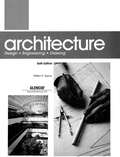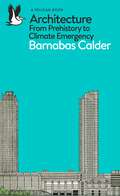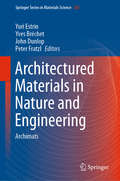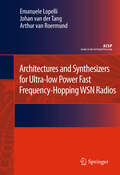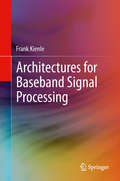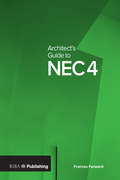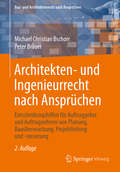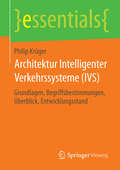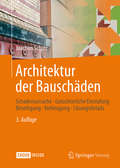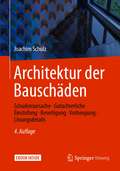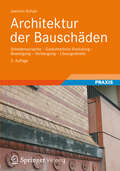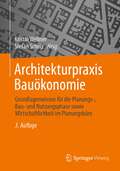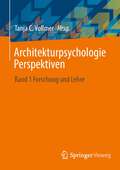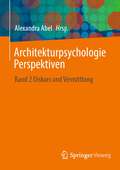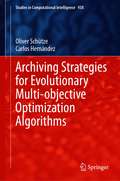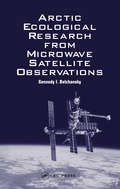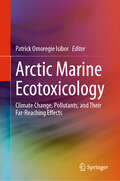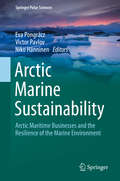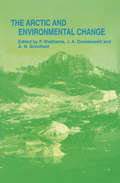- Table View
- List View
Architecture: Design, Engineering, Drawing
by William Perkins SpenceDesigned especially for college design courses and drafting classes, the text provides an overview of the planning and design of residential and commercial buildings
Architecture: From Prehistory to Climate Emergency (Pelican Books)
by Barnabas CalderA groundbreaking history of architecture told through the relationship between buildings and energyThe story of architecture is the story of humanity. The buildings we live in, from the humblest pre-historic huts to today's skyscrapers, reveal our priorities and ambitions, our family structures and power structures. And to an extent that hasn't been explored until now, architecture has been shaped in every era by our access to energy, from fire to farming to fossil fuels.In this ground-breaking history of world architecture, Barnabas Calder takes us on a dazzling tour of some of the most astonishing buildings of the past fifteen thousand years, from Uruk, via Ancient Rome and Victorian Liverpool, to China's booming megacities. He reveals how every building - from the Parthenon to the Great Mosque of Damascus to a typical Georgian house - was influenced by the energy available to its architects, and why this matters.Today architecture consumes so much energy that 40% of the world's greenhouse gas emissions come from the construction and running of buildings. If we are to avoid catastrophic climate change then now, more than ever, we need beautiful but also intelligent buildings, and to retrofit - not demolish - those that remain. Both a celebration of human ingenuity and a passionate call for greater sustainability, this is a history of architecture for our times.
Architectured Materials in Nature and Engineering: Archimats (Springer Series in Materials Science #282)
by John Dunlop Yuri Estrin Yves Bréchet Peter FratzlThis book deals with a group of architectured materials. These are hybrid materials in which the constituents (even strongly dissimilar ones) are combined in a given topology and geometry to provide otherwise conflicting properties. The hybridization presented in the book occurs at various levels - from the molecular to the macroscopic (say, sub-centimeter) ones. This monograph represents a collection of programmatic chapters, defining archimats and summarizing the results obtained by using the geometry-inspired materials design. The area of architectured or geometry-inspired materials has reached a certain level of maturity and visibility for a comprehensive presentation in book form. It is written by a group of authors who are active researchers working on various aspects of architectured materials. Through its 14 chapters, the book provides definitions and descriptions of the archetypes of architectured materials and addresses the various techniques in which they can be designed, optimized, and manufactured. It covers a broad realm of archimats, from the ones occurring in nature to those that have been engineered, and discusses a range of their possible applications. The book provides inspiring and scientifically profound, yet entertaining, reading for the materials science community and beyond.
Architectures and Circuits for Distributed Quantum Computing (Springer Theses)
by Daniele CuomoThis thesis treats networks providing quantum computation based on distributed paradigms. Compared to architectures relying on one processor, a network promises to be more scalable and less fault-prone. Developing a distributed system able to provide practical quantum computation comes with numerous challenges, each of which need to be faced with careful analysis in order to create a seamless integration of multiple engineered components.In accordance with hardware technologies, currently under development worldwide, telegates represent the fundamental inter-processor operations. Each telegate consists of several tasks: i) entanglement generation and distribution, ii) local operations, and iii) classical communications. Entanglement generation and distribution is an expensive resource, as it is time-consuming. The primary contribution of this thesis lies in the extensive analysis of some complex scenarios of general interest. We propose numerical models that help to identifythe interdependence between computation and communication. With the support of some of the best tools for reasoning -- i.e. network optimization, circuit manipulation, group theory and ZX-calculus -- we lay out new perspectives on the way a distributed quantum computing system should be developed.
Architectures and Synthesizers for Ultra-low Power Fast Frequency-Hopping WSN Radios (Analog Circuits and Signal Processing)
by Arthur H.M. van Roermund Emanuele Lopelli Johan van der TangWireless sensor networks have the potential to become the third wireless revolution after wireless voice networks in the 80s and wireless data networks in the late 90s. Unfortunately, radio power consumption is still a major bottleneck to the wide adoption of this technology. Different directions have been explored to minimize the radio consumption, but the major drawback of the proposed solutions is a reduced wireless link robustness. The primary goal of Architectures and Synthesizers for Ultra-low Power Fast Frequency-Hopping WSN Radios is to discuss, in detail, existing and new architectural and circuit level solutions for ultra-low power, robust, uni-directional and bi-directional radio links. Architectures and Synthesizers for Ultra-low Power Fast Frequency-Hopping WSN Radios guides the reader through the many system, circuit and technology trade-offs he will be facing in the design of communication systems for wireless sensor networks. Finally, this book, through different examples realized in both advanced CMOS and bipolar technologies opens a new path in the radio design, showing how radio link robustness can be guaranteed by techniques that were previously exclusively used in radio systems for middle or high end applications like Bluetooth and military communications while still minimizing the overall system power consumption.
Architectures for Baseband Signal Processing
by Frank KienleThis book addresses challenges faced by both the algorithm designer and the chip designer, who need to deal with the ongoing increase of algorithmic complexity and required data throughput for today's mobile applications. The focus is on implementation aspects and implementation constraints of individual components that are needed in transceivers for current standards, such as UMTS, LTE, WiMAX and DVB-S2. The application domain is the so called outer receiver, which comprises the channel coding, interleaving stages, modulator, and multiple antenna transmission. Throughout the book, the focus is on advanced algorithms that are actually in use in modern communications systems. Their basic principles are always derived with a focus on the resulting communications and implementation performance. As a result, this book serves as a valuable reference for two, typically disparate audiences in communication systems and hardware design.
Architect’s Guide to NEC4
by Frances ForwardThis user friendly guide introduces, explains, and demystifies the NEC4 contract on a practical, work-based level. Made for architects by an architect, it explores the best approach to collaborative and contractual partnering work practices. Alongside explanations of the contracts and clauses, it presents the key areas of distinction from alternative standard form contracts and examines the integrated project management principles that bring the NEC4 contracts together as a whole. It's the perfect companion book for professionals who are new to the NEC contract family and former users trying to understand the latest updates.
Architekten- und Ingenieurrecht nach Ansprüchen: Entscheidungshilfen für Auftraggeber und Auftragnehmer von Planung, Bauüberwachung, Projektleitung und -steuerung (Bau- und Architektenrecht nach Ansprüchen)
by Michael Christian Bschorr Peter BräuerNach Anspruchsgrundlagen geordnet werden die tatbestandlichen Voraussetzungen aller relevanten Ansprüche von Auftraggebern und Auftragnehmern von Planungs-, Objektüberwachungs-, Projektleistungs- und Projektsteuerungsleistungen dargestellt. Ablaufdiagramme und graphische Erläuterungen bieten dem Leser einen schnellen Überblick und praxisnahe Hilfestellungen. Die vorliegende 2. Auflage berücksichtigt das zum 1. Januar 2018 reformierte Werkvertragsrecht des BGB.
Architektur Intelligenter Verkehrssysteme: Grundlagen, Begriffsbestimmungen, Überblick, Entwicklungsstand (essentials)
by Philip KrügerPhilip Krüger liefert einen Überblick zur Architektur Intelligenter Verkehrssysteme (IVS) und vermittelt wichtige Grundlagen und Entwicklungstrends im Themenfeld. Der Autor beschreibt den Fortschritt in Deutschland zur Erarbeitung einer umfassenden und intermodalen IVS-Architektur und bewertet diesen genauer. Für die koordinierte und harmonisierte Weiterentwicklung von IVS werden Rahmenbedingungen benötigt, wie sie in einer nationalen IVS-Architektur beschrieben sind. Dabei darf eine nationale IVS-Architektur nicht als Hemmnis für Innovationen verstanden werden, sondern vielmehr als Basis jeder systematischen Weiter- und Neuentwicklung von IVS.
Architektur der Bauschäden: Schadensursache - Gutachterliche Einstufung - Beseitigung - Vorbeugung - Lösungsdetails
by Joachim SchulzAnhand von ca. 110 Beispielen, untergliedert nach Bauteilen, werden Planungs- und Ausführungsfehler vorgestellt und wie folgt analysiert: - Schadensursache - gutachterliche Einstufung - Beseitigung - Vorbeugung Nach dem Motto "Bauen ist ein Kampf mit dem Wasser" wird als Schwerpunktthema der Bereich Feuchteschäden an Balkonen, Terrassen, WU-Beton-Kellern, Lichtschächten, Kelleraußentreppen, Rampen usw. behandelt. Da durch mangelhafte Ausführung aus guten Baustoffen oft schlechte Bauteile entstehen, soll der Planer vorbeugend auf mögliche Ausführungsfehler aufmerksam gemacht werden. Die 2. Auflage wurde überarbeitet und um neue aktuelle Beispiele ergänzt.
Architektur der Bauschäden: Schadensursache - Gutachterliche Einstufung - Beseitigung - Vorbeugung - Lösungsdetails
by Joachim SchulzAnhand von ca. 170 Beispielen, mit über 120 Prinzipskizzen, untergliedert nach Bauteilen, werden Planungs- und Ausführungsfehler vorgestellt und wie folgt analysiert: Schadensursache - gutachterliche Einstufung - Beseitigung - Vorbeugung. Nach dem Motto "Bauen ist ein Kampf mit dem Wasser" wird als Schwerpunktthema der Bereich Feuchteschäden an Balkonen, Terrassen, WU-Beton-Kellern, Lichtschächten, Kelleraußentreppen, Rampen usw. behandelt. Da durch mangelhafte Ausführung aus guten Baustoffen oft schlechte Bauteile entstehen, soll der Planer vorbeugend auf mögliche Ausführungsfehler aufmerksam gemacht werden. Die 4. Auflage wurde überarbeitet, aktualisiert und um neue Beispiele und Themenkomplexe ergänzt.
Architektur der Bauschäden: Schadensursache - Gutachterliche Einstufung - Beseitigung - Vorbeugung - Lösungsdetails
by Joachim SchulzAnhand von ca. 110 Beispielen, untergliedert nach Bauteilen, werden Planungs- und Ausführungsfehler vorgestellt und wie folgt analysiert: - Schadensursache - gutachterliche Einstufung - Beseitigung - Vorbeugung Nach dem Motto "Bauen ist ein Kampf mit dem Wasser" wird als Schwerpunktthema der Bereich Feuchteschäden an Balkonen, Terrassen, WU-Beton-Kellern, Lichtschächten, Kelleraußentreppen, Rampen usw. behandelt. Da durch mangelhafte Ausführung aus guten Baustoffen oft schlechte Bauteile entstehen, soll der Planer vorbeugend auf mögliche Ausführungsfehler aufmerksam gemacht werden. Die 2. Auflage wurde überarbeitet und um neue aktuelle Beispiele ergänzt.
Architektur der digitalen Transformation: Digital Business, Technologie, Entscheidungsunterstützung, Management
by Lakhmi C. Jain Rainer Schmidt Alfred ZimmermannDieses forschungsorientierte Buch enthält wichtige Beiträge zur Gestaltung der digitalen Transformation. Es umfasst die folgenden Hauptabschnitte in 20 Kapiteln:- Digitale Transformation- Digitales Geschäft- Digitale Architektur- Entscheidungshilfe- Digitale Anwendungen Es konzentriert sich auf digitale Architekturen für intelligente digitale Produkte und Dienstleistungen und ist eine wertvolle Ressource für Forscher, Doktoranden, Postgraduierte, Absolventen, Studenten, Akademiker und Praktiker, die sich für die digitale Transformation interessieren.
Architekturpraxis Bauökonomie: Grundlagenwissen für die Planungs-, Bau- und Nutzungsphase sowie Wirtschaftlichkeit im Planungsbüro
by Regina Zeitner Stefan Scholz Kristin Wellner Clemens Schramm Marcus Hackel Anne HackelDieses Lehrbuch stellt das komplexe Tätigkeitsfeld des Architekten aus planungs- und bauökonomischer Sicht dar. Die Aufgaben des Architekten werden prozessorientiert im Sinne eines Qualitätsmanagementsystems vermittelt beginnend bei den Kernprozessen der Planung bis zur Realisierung des Bauvorhabens.
Architekturpraxis Bauökonomie: Grundlagenwissen für die Planungs-, Bau- und Nutzungsphase sowie Wirtschaftlichkeit im Planungsbüro
by Stefan Scholz Kristin WellnerDieses Lehrbuch stellt das komplexe Tätigkeitsfeld der Architekt*innen aus planerischer-, bauökonomischer und immobilienwirtschaftlicher Sicht dar. Die Aufgaben des*der Architekt*in werden prozessorientiert im Sinne des Planungs- und Bauprozesses dargestellt. Ein weiteres Thema ist die Wirtschaftlichkeit im Architekturbüro selbst. Das Lehrbuch gibt so – aufbauend auf den Einführungstexten in die Bauökonomie und Immobilienwirtschaft – einen Überblick über alle für die Architekt*innentätigkeit relevanten ökonomischen Inhalte und vertieft die besonders praxisrelevanten Themen ausführlich. Neu in der 3. Auflage: Das Thema Haftung wurde komplett überarbeitet und alle Rechtsthemen aktualisiert. Außerdem wurde Wert auf die übergreifende Einbindung der Bedeutung von Lebenszykluskostenanalyse und Digitalisierung gelegt.
Architekturpsychologie Perspektiven: Band 1 Forschung und Lehre
by Tanja C. VollmerWas können wir aus der Forschung über die Wirkung von Architektur auf Gesundheit und Erleben der Menschen lernen? Wie vermitteln wir die interdisziplinären Erkenntnisse heute und morgen? In diesem Buch wird die Architekturpsychologie als Schlüsselkonzept der gesundheitsbezogenen Evidence Based Design Forschung vorgestellt. Dabei entwickeln renommierte Wissenschaftler:innen aus Deutschland, Dänemark und der Schweiz anhand verständlicher Beispiele ihre Forschungs- und Lehrperspektiven u.a. zum Krankenhaus-, Schul- und Städtebau sowie zum Design. Unterschiede der phänomenologischen, explorativen und empirischen Forschung werden herausgearbeitet sowie hilfreiche Modelle und Konzepte der modernen Architekturpsychologie erklärt. Einleitend wirft der Band einen Blick auf Entstehung und aktuellen Stand der Architekturpsychologie in Deutschland.
Architekturpsychologie Perspektiven: Band 2 Diskurs und Vermittlung
by Alexandra AbelIn der gebauten und vom Menschen beeinflussten Umwelt manifestiert sich unser Leben: Lebenshaltung, Lebensformen, Lebensentwurf. Indem man Architektur neu denkt, hat man daher das Potential, die derzeitige Form unseres Lebens zu überdenken. Ein solches Neu, Anders braucht eine Sensibilisierung für die Relevanz der gebauten Umwelt, für die Werte und Zielgrößen, die hinter einer bestimmten Gestaltung stehen und braucht einen gesamtgesellschaftlichen Diskurs zu der zentralen Frage: Wie wollen wir leben? Wie dürfen wir leben? Vor dem Hintergrund ökologischer und ökonomischer Fairness: Welche Lebensformen sind kompatibel mit einer möglichst hohen Lebensqualität für uns alle, als Teil eines Ökosystems, mit dem unser Wohlbefinden unauflöslich verbunden ist. In diesem Band kommen namhafte Expertinnen aus Österreich, der Schweiz und Deutschland aus den Disziplinen der Architektur, der Psychologie, der Kunst und Kunstdidaktik zu Wort, die sich zu der Relevanz und zu den Voraussetzungen einer solchen Debatte äußern.
Architekturpsychologie Perspektiven: Band 3 Entwurf und Prozess
by Martina GuhlWie findet die Begegnung von Psychologie und Architektur während des Entwurfs- und Planungsprozesses statt? In welchem Planungsabschnitt wird architekturpsychologisches Wissen relevant und einsetzbar? Welche Erkenntnisse liefert die urbane Architekturpsychologie für den städtebaulichen Diskurs? In diesem Buch bringen renommierte Expert*innen aus Deutschland, der Niederlande und der Schweiz aus den Disziplinen Architektur, Psychologie, Städtebau, Farbgestaltung und Kommunikationspsychologie ihr Pionierwissen ein.
Archiving Strategies for Evolutionary Multi-objective Optimization Algorithms (Studies in Computational Intelligence #938)
by Carlos Hernández Oliver SchützeThis book presents an overview of archiving strategies developed over the last years by the authors that deal with suitable approximations of the sets of optimal and nearly optimal solutions of multi-objective optimization problems by means of stochastic search algorithms. All presented archivers are analyzed with respect to the approximation qualities of the limit archives that they generate and the upper bounds of the archive sizes. The convergence analysis will be done using a very broad framework that involves all existing stochastic search algorithms and that will only use minimal assumptions on the process to generate new candidate solutions. All of the presented archivers can effortlessly be coupled with any set-based multi-objective search algorithm such as multi-objective evolutionary algorithms, and the resulting hybrid method takes over the convergence properties of the chosen archiver. This book hence targets at all algorithm designers and practitioners in the field of multi-objective optimization.
Arctic Ecological Research from Microwave Satellite Observations
by Gennady I. BelchanskyActive (imaging radar) and passive (radiometer) microwave systems are increasingly used for Arctic ecological research. Unfortunately, until now ecologists interested in remote sensing often lacked access to the full suite of physical and analytical techniques of microwave systems, data processing, and ecological applications because a suitable ref
Arctic Marine Ecotoxicology: Climate Change, Pollutants, and Their Far-Reaching Effects
by Patrick Omoregie IsiborThis book explores the fragile Arctic marine environment from the perspective of marine toxicology, shedding light on the intricate relationship between pollution, contaminants, and Arctic ecosystems. It examines the challenges of preserving this delicate habitat and the need to conserve the inherent lifeforms found there. The book introduces the unique characteristics of Arctic marine life. It delineates climate change and the effects of pollutants, analyzing their far-reaching impacts on the complex waters of Arctic marine toxicology. It also examines the regulatory frameworks required to safeguard these vulnerable ecosystems and presents case studies and ethical considerations. Fundamentals of Arctic Marine Toxicology: Climate Change, Pollutants, and Their Far-Reaching Effects is a valuable resource for researchers, policymakers, industry professionals, and environmental stewards. Its interdisciplinary approach encompasses climate change, conservation, biology, environmental science, and toxicology. It offers a holistic understanding of the Arctic's ecological intricacies and the challenges posed by anthropogenic disturbances caused by human activities motivated by economic gain. The book serves as a guide towards a future of eco-friendly innovations that align with environmental stewardship. It envisions a world of sustainable Arctic marine ecosystems achieved through responsible and sustainable practices.
Arctic Marine Sustainability: Arctic Maritime Businesses and the Resilience of the Marine Environment (Springer Polar Sciences)
by Eva Pongrácz Victor Pavlov Niko HänninenThis book presents the latest scientific views on resource use conflicts in the Arctic seas. The main areas of focus are the biological resources of Arctic seas vs. exploitation of oil and gas resources, and the conflicts in between. In addition, climate change is presented as a stressor, which both limits and facilitates the economic availability of resources in the Arctic. The book is divided into five parts. Part 1 examines Arctic ecosystems, resilience of the marine environment and possible conflicts between industrial sector and biological world. The focus of Part 2 is on transport infrastructure along the northern routes. Issues such as Arctic maritime operations, black carbon and unmanned aerial vehicles are considered. Part 3 focuses on resource use conflicts in Arctic seas and on the most recent threats in terms of Arctic oil and gas exploration, offshore logistics operations as well as transportation of oil and oil products. Discussions in Part 4 of the book are concentrated around social aspects and involvement of local communities. Tourism development, preservation of indigenous culture, engagement of communities on relevant Arctic issues, search and rescue in the cold marine environment are examples of questions raised. The book reviews Arctic-specific petroleum regulations, the state of preparedness to oil spill accidents in the region as well as the latest developments in oil spill response technologies and their limitations. Search and rescue operations are reviewed and how working in this harsh Arctic environment affects the ability of rescue technicians to perform the required technical skills. Part 5 considers the sustainability challenges arising from the marine resource exploitation. The focus is on the vulnerability of Arctic ecosystems to disturbance – both natural and anthropogenic.
Arctic and Environmental Change
by J. A. DowdeswellThis timely book presents a wide-ranging review of Arctic environmental change in response to global warming, and gives a broad insight into the transformation of the Arctic which we can expect during the next century. It is in high northern latitudes that we can expect to observe global warming at its most powerful, making it a natural laboratory where climate changes and their impacts can be monitored and studied more readily than elsewhere in the world. Fourteen authoritative reviews cover the predictions of warming rates by General Circulation Models; variabilities in atmospheric circulation and moisture flux; the dynamics of the polar vortex in the Arctic and its role in ozone loss; the countervailing influence of air pollution in reducing solar irradiance; and the impact of climatic change on Arctic terrestrial and marine ecosystems. Also detailed are the thermohaline circulation of the ocean, the extent and thickness of sea ice, the sizes of glaciers and ice sheets, and the extent of permafrost. Moving to past changes, the records from Greenland ice cores and deep ocean drilling are reviewed for what they tell us about past climates and glaciation in the Arctic., The book paints a vivid and disturbing picture of the enhanced warming that can be expected in the Arctic relative to lower latitudes, and of the major impacts that this will have on the northern cryosphere. It will be an invaluable reference for anyone seeking a greater understanding of the factors and processes affecting the arctic environment, which may ultimately have a major impact on global climatic change.
Arde la luz: Guía para entender el precio de la electricidad
by Ignacio Gistau CosculluelaUna explicación clara y concisa del mercado eléctrico, un debate de rabiosa actualidad. En las noticias, en las primeras páginas de los periódicos, en acaloradas conversaciones con amigos. Unánime en la indignación, la sociedad tiene tantas soluciones como personas la conforman. Pero ¿cuál es la realidad del mercado eléctrico? ¿Cómo se forman los precios? Y sobre todo: ¿son excesivos? Ignacio Gistau ha dedicado toda su carrera profesional a los mercados de la energía de España, Alemania y Reino Unido. Tras más de veinte años conociendo en primera persona la evolución de los mercados eléctricos globales, ofrece claves sencillas y comprensibles para entender el actual precio de la electricidad.
Arduino Cookbook (Oreilly And Associate Ser.)
by Michael MargolisCreate your own toys, remote controllers, alarms, detectors, robots, and many other projects with the Arduino device. This simple microcontroller board lets artists and designers build a variety of amazing objects and prototypes that interact with the physical world. With this cookbook you can dive right in and experiment with more than a hundred tips and techniques, no matter what your skill level is.The recipes in this book provide solutions for most common problems and questions Arduino users have, including everything from programming fundamentals to working with sensors, motors, lights, and sound, or communicating over wired and wireless networks. You'll find the examples and advice you need to begin, expand, and enhance your projects right away.Get to know the Arduino development environmentUnderstand the core elements of the Arduino programming languageUse common output devices for light, motion, and soundInteract with almost any device that has a remote controlLearn techniques for handling time delays and time measurementUse simple ways to transfer digital information from sensors to the Arduino deviceCreate complex projects that incorporate shields and external modulesUse and modify existing Arduino libraries, and learn how to create your own
